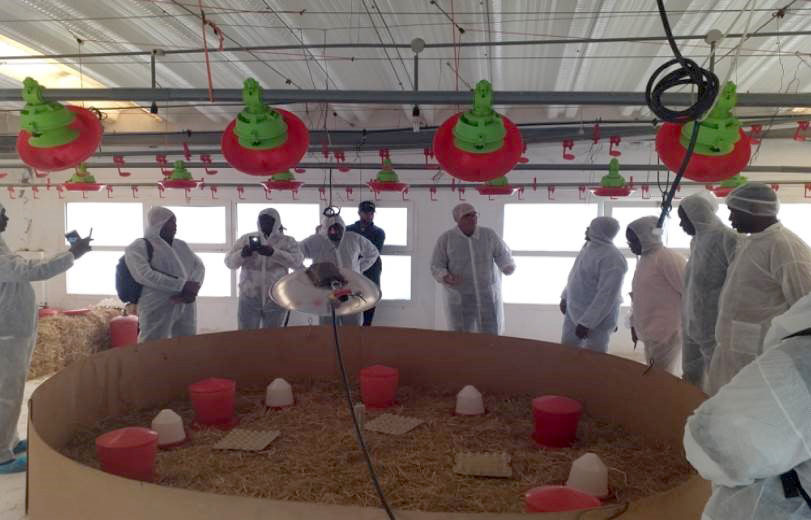Simultaneously developing the capacity of local agricultural producers and trade policies and standards that allow the open flow of food products from across borders has long helped countries build their economies while providing citizens high-quality and affordable food.
Providing technical, economic and logistical assistance toward these dual goals is the heart of the U.S. Grains Council’s (USGC’s) long-term strategy in Africa, where the United Nations estimates demand for meat, milk and eggs will quadruple by 2050. This surge is being fueled by the fastest population growth in the world even while an estimated 237 million people in Sub-Saharan Africa suffer from chronic undernutrition.
“The Council is continuing to invest in dual-focused programs in East and West Africa that address challenges hindering capacity development within poultry and livestock industries as well as trade servicing for the use of coarse grains and co-products,” said Katy Wyatt, USGC manager of global strategies.
“These programs allow the Council to be strategic in its long-term market development programming and support local industries in addressing both short and long-term production constraints – building the markets of tomorrow, today.”
More than half the world’s low-income and food-deficit countries – 43 – are in Africa. A growing middle-class population, rapid urbanization, rising food prices, low agricultural stocks and other environmental and political factors represent major hurdles to meeting basic food needs.
Compounding and highlighting these concerns is an unprecedented outbreak of desert locusts in Africa, which spread from Ethiopia and Kenya to more than 10 countries on the continent. Trillions of locusts are devastating agricultural crops, with the next generation expected to hatch in Kenya in mid-June, immediately before the country’s most important harvest season.
A modest locust swarm – 40 million insects – can consume the food of 35,000 people in a single day. As a result, the Food and Agriculture Organization (FAO) of the United Nations estimates up to 25 million people in East Africa will struggle with food security by the latter half of 2020.
“The locust outbreak is alarming but demonstrates the critical importance of agricultural sectors having the capacity to address threats to production with a full suite of tools – from production efficiency to imports,” Wyatt said. “Shocks will always be felt in agricultural sectors – no matter the country – but countries and regions with functioning, sustainable agricultural value chains remain better positioned to address these events.”
Poultry training programs in East and West Africa, modeled after successful programs that have run in North Africa for decades, exemplify the Council’s investment in developing local capacity along with long-term feed grain markets for U.S. farmers with exportable supply.
With funding from the U.S. Department of Agriculture (USDA), the Council is providing technical training and hands-on skills to help poultry producers learn how to address and mitigate production constraints and challenges. Since 2017, more than 265 individuals from eight West African countries have attended training sessions with the Moroccan Poultry Association (FISA) in Casablanca. The programs cover topics like poultry farm management, egg layer production and biosecurity coupled with hands-on training at FISA’s poultry farm and field visits to local feed milling companies and poultry processing plants.
“These programs allow African poultry producers to witness firsthand how commercial poultry and feed companies operate in Morocco and determine how the lessons learned can be replicated in their own communities,” Wyatt said. “This strengthens poultry farming and management skills among producers and industry associations while also helping the Council forge relationships with leading companies.”
The Council is also encouraging the establishment of stable trade policy in the region, which would allow U.S. coarse grains and co-products to serve as a viable option for helping African countries address supply shortages and increasing feed prices.
The Council submitted comments to the U.S. Trade Representative (USTR) for trade talks with Kenya, for example, encouraging the removal of cost-prohibitive tariffs that limit export potential and supporting chapters on sanitary and phytosanitary issues and biotech restrictions. The U.S.-Kenya agreement under negotiation now is widely seen as a model for future agreements between the United States and African nations.
Together, the focus on short-term technical assistance, long-term capacity building and trade policy that will solidify relationships in the food chain for generations is a strategy the Council believes will truly fulfill its mission of developing markets, enabling trade and improving lives in Africa.
Learn more about the Council’s work in Africa.
About The U.S. Grains Council
The U.S. Grains Council develops export markets for U.S. barley, corn, sorghum and related products including distiller’s dried grains with solubles (DDGS) and ethanol. With full-time presence in 28 locations, the Council operates programs in more than 50 countries and the European Union. The Council believes exports are vital to global economic development and to U.S. agriculture’s profitability. Detailed information about the Council and its programs is online at www.grains.org.

